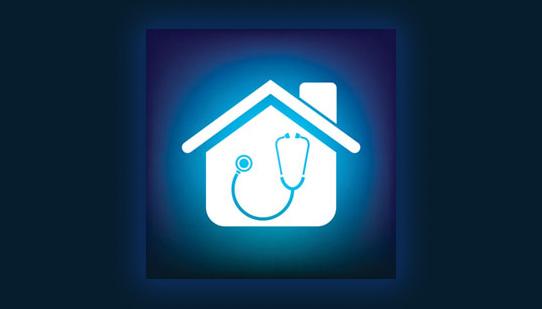
Not Gloom and Doom: Demystifying Hospice

For some, “hospice” is a vague idea whose connection to death leads to outright rejection before the true facts are known.
In fact, hospice neither prolongs life nor hastens death. Instead, it offers practical care and support at a difficult and sometimes traumatic time.
“People should think about hospice as a comfort measure, not gloom and doom,” says Janet Neigh, executive director of the Hospice Association of America (HAA). “There’s a misconception that hospice is a place. It’s actually a concept, an approach to care for people who have a terminal illness.”
Hospice care helps those with a limited life expectancy — and their caregivers — live each remaining day to the fullest possible, says Neigh.
Supportive care
Hospice care is palliative — focused on making the patient as comfortable as possible — not an effort at major medical intervention.
Hospice provides a combination of physicians, registered nurses, home health aides, counselors, social workers and trained volunteers who meet the physical, emotional and spiritual needs of patients, their loved ones and caregivers.
Care can include providing pain relief, bathing and dressing, preparing meals, running errands, doing household chores and providing informed answers to questions. Specialized equipment, such as alternating pressure mattresses, can be made available at the person’s home.
Hospice also provides services for family members, such as bereavement counseling and support groups, for up to a full year after a loved one passes on.
Eligibility and payment
Generally, a person must be certified by a medical doctor as having a terminal illness and probably having six months or less to live, in order to receive two consecutive 90-day periods of hospice benefits. However, coverage can be extended — for years in some cases — so long as the doctor’s prognosis of six months or less to live is regularly renewed.
People with ALS also may become eligible for hospice care if a doctor certifies they have “rapid functional decline,” whether or not they demonstrate specific declining health characteristics.
Hospice policies vary from facility to facility. Most hospices accept people with pre-existing feeding tubes and some programs also accept patients who already are vented. In a few cases, hospices have rejected people with ALS who are taking Rilutek, a drug that prolongs survival. The local MDA clinic doctor is a good resource when considering hospice.
The great majority of hospice patients have their expenses covered by Medicare Part A. Most private insurances also cover hospice expenses. Less than 1 percent of hospice patients pay out of their own pockets. Other sources of coverage include Medicaid and charitable assistance. (Note: Get expensive equipment such as power wheelchairs and communication devices before entering hospice, as insurance won’t pay for these items afterward.)
Where is care provided?
Far and away the most common setting for hospice care is the person’s own home or that of a family member. Hospice facilities, acute care facilities, nursing facilities and hospitals are utilized to a much smaller extent.
Hospice patients may receive different levels of care in different settings and may move from one setting to another depending on the level of care required. The goal is to ensure that neither patients nor families have to confront a crisis situation on their own.
Routine home care
More than 95 percent of hospice patients — those whose symptoms are under control — receive this type of in-home care, which can include the following:
- Registered nurse visits
- Physician and specialist services
- Home health aide visits
- Medications
- Medical equipment and supplies
- Lab and diagnostic studies
- Counseling (dietary, spiritual, bereavement)
- Therapy (speech, physical)
- A hospice nurse on call 24 hours a day
Inpatient care
Patients whose symptoms aren’t being controlled at home may temporarily go to an acute care facility where their condition can be monitored continuously and medications prescribed. When symptoms are brought under control or an acceptable comfort level has been achieved, they can return to routine home care.
Continuous home care
Similar to inpatient care, this level of care differs in that the patient whose symptoms are proving troublesome chooses to stay at home under the continuous care of a hospice nurse. Continuous care is usually considered a short-term situation, and its need is evaluated every 24 hours.
Respite care
Family caregivers, especially in end-of-life circumstances, are under tremendous physical and emotional strain. When they need a break, respite care allows their loved one to stay in an around-the-clock care facility for up to five days at a time before returning home.
No matter the level of care, if a person’s health improves significantly, hospice services can be discontinued. Hospice patients also can, for any reason, sign a revocation statement that cancels their hospice services.
Sooner is better than later
“One of our biggest challenges is getting families to recognize that hospice should be utilized earlier than the last two weeks of life,” says Neigh, of the Hospice Association of America. A minimum of 30 days is needed to really reap the benefits of the program, she says.
“The first week is spent just figuring out patient and family needs,” she says. “It’s a time to get things stabilized. Family and patient have time to adjust to the fact that this is nearing the end. It’s time to do a life review, perhaps to have family and friends come from other parts of the country. It’s an adaptive process. It’s a special time of life.”
People with ALS, family members or caregivers should talk to the ALS health care team about hospice well before they think it’s “the end.”
“Doctors at MDA clinics are very familiar with this issue, and often broach the subject on their own,” notes Scott Wiebe, MDA director of outreach initiatives and the MDA/ALS Division.
Jane Irvine’s mother died from complications of ALS 40 years ago, before hospice existed, and Irvine says that was a primary reason she went into hospice work. She is now the director of home health and extended care at Hospice of the Valley in Phoenix, Ariz., the country’s largest hospice facility.
“I still run through my mind how my mother’s decline and death could have been handled differently. I would have given anything for more support,” she says. “If only hospice had been available at that time, it would have been a lifeline for my mother and me. Though I regret what did not happen for us, I take solace in knowing that the support system offered by hospice is available now for others who walk the same journey."
Resources
Hospice Association of America
(202) 546-4759
www.nahc.org/haa/
National Association for Home Care & Hospice
(202) 547-7424
www.nahc.org
National Hospice and Palliative Care Organization
(800) 658-8898
www.nhpco.org
Medicare Hospice Benefits (publication CMS 02154)
U.S. Department of Health and Human Services
(800) 633-4227
www.medicare.gov